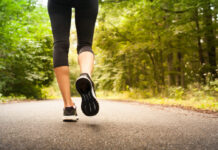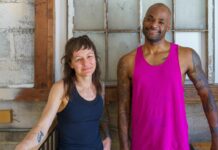In my Irish clan, we’ll occasionally Irish step dance at weddings and funerals. But, recently, all on my own and a bit tentative-feeling, I went square dancing. I opened the doors to Mobtown Ballroom in Pigtown, and was hit with the power of fun. A bluegrass band was going full throttle; the craft beer was strong; a caller was charming dancers with shouts of “do-si-do,” “promenade” and “wheel around”; and the whole building was pulsing with stomping, spinning, clapping fools. Square dancing. Square dancing!
Still, I felt a little shy watching the joyous, somewhat clumsy dancers swing each other with abandon. My Irish step dancing experiences were few and far between, and I began to doubt myself: Did I have what it takes to whirl around the room in different formations, barely able to hear what dance move was being called? Even if I could hear, I wouldn’t know the move anyway. Could I take the pressure on the dance floor?
I knew I wouldn’t be able to look myself in the mirror the next morning if I passed up this opportunity. I had to give a twirl. So I joined an “8”—that’s square dancing parlance for the cluster of folks you dance with—and prayed someone in my “8” knew what they were doing. The music started. My mind went blank. There was no hesitation. There was no ego. Next thing I knew, I was two-stepping with a stranger, and, soon after, found myself in the arms of several others as we spun, as fast as possible, in the “basket hold.” It felt like we were taking off in flight.
We were soon dancing our square through and “peeling the top” (lead dancers peel off; trailing dancers step forward). It was pure fun—super fun.
And that makes perfect sense to Susanne Liebich, a Boston-based professional dance instructor and movement therapist who founded and directs Dancing Wellness/Healing Motion for Life. Synchronized dancing (including square dancing) is more than merely learning steps, notes Liebich, who leads dance and wellness classes for people with Parkinson’s and dementia, vets with PTSD and seemingly healthy everyday Joes. And it offers considerably more than a higher readout on your Fitbit.
According to Liebich, it’s also a way to boost healing and connect with others. “Dance builds neuropathways that help to circumvent that part of the brain that has been damaged by disease,” she explains.
Liebich adds that while a lot of dance is “right brain,” it’s “left brain,” too: “In dance, there are things like patterns and sequence. There’s a process. And those elements of dance are very left brain. Then there are other parts that are right brain: Dancing is artistic, emotional, communal.”
Dancing in a social setting is good for you in a big way, she points out. Just look at all those square dancers catching their partners and swinging around. “They feel joy,” she says. “And when they feel joy, then they don’t feel pain. You don’t notice your problems when you’re feeling joy.”
Does square dancing equal joy for everyone? I’m not certain, but I definitely felt sparks flying from all the whipping around, and a bellyache from the laughter. Now I’m on the hunt for a skirt that will flare fiercely for my next wholesome do-si-do.




